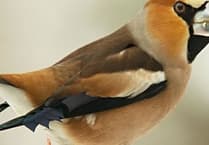At the end of November a small, brown, inconspicuous bird was trapped in a mist net set up at Tices Meadow.
Such birds are known in birding circles as Little Brown Jobs (LBJ) and this tiny fella was identified as a Little Bunting thanks to the close-up examination.
It is a very rare visitor to the British Isles as it breeds in the dwarf willow zone in the northern tundra of Russia but overwinters in China and south east Asia.
It should have flown eastwards, but instead went towards Europe, the UK and Tices.
Why is a mystery, but a handful of Little Buntings have been doing this since the 1930s. This pushes the number of bird species seen at Tices in 2024 to 135. Amazing.
Other unusual bird movements now regularly occur in southern England.
Blackcaps are a summer visitor, which winters in north Africa, but over the past few years when the British birds have migrated there is a considerable influx of birds from central Europe which then overwinter here.
This is thought to be another example of adaptation to climate change. As our winters become milder, some Blackcaps started flying to England where the mildness is exaggerated in urban areas, and there is a plentiful supply of food in garden bird feeders.
Returning to the Emberiza, or Bunting family, one may hope to see two other members at Tices Meadow.
The Reed Bunting is an established breeder in the Tices reed beds, as the name suggests.
The male Reed Bunting in breeding plumage is a very handsome bird, with a black head, white collar and white drooping moustache.
Like all buntings they are seed eaters and are declining in numbers due to changes in agricultural practices. This is also true of the other bunting which is very occasionally seen at Tices, the Yellowhammer.

This bird, which often frequents lowland farms, is recognised by its bright yellow plumage and characteristic ‘a little bit of bread and no chee-eese’ song, often delivered from a prominent position.
On a more positive note, there is a healthy flock of cousins of Buntings at Tices. I refer to the House Sparrow which can be seen and heard in the trees lining the River Blackwater.
There seems to be dozens of them, which is very cheering considering the long-term trend is downwards as numbers have reduced by 70 per cent since the 1970s.
The house sparrow is an opportunistic bird of urban areas, parks and farmland which feeds on seeds, grain and invertebrates and is a lover of bird feeder.
They live in colonies and nest in cracks and crevices in buildings, along with ivy and dense bushes, with their decline being blamed on changes to climate, agriculture and building practices.
The House Sparrow has a close association with man and has been introduced from its natural range of Europe and Asia to every other continent, except Antarctica, and is considered to be one of the most widespread birds in the world.


